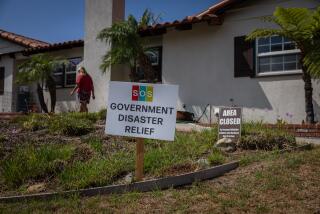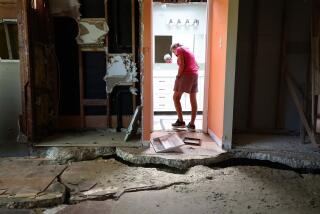Delivery of New Mail Center Delayed by Quake : Postal Service: The $123-million Valencia complex underwent $5 million in repairs. It now awaits the arrival of equipment, and more than 1,500 employees from Van Nuys.
VALENCIA â More than a year after the Northridge earthquake badly damaged a new, $123-million mail-processing complex in Valencia, the facility remains only partly operational, with about 80 workers sorting third-class bulk mail.
Postal officials now expect the center, which before the earthquake was touted as a model of state-of-the-art efficiency, to be operating fully on May 6. On that date, the rest of the 1,600 postal employees set to work at the plant will be transferred to Valencia from Van Nuys.
The hilltop postal facility near Magic Mountain was intended to replace the old and cramped mail-processing center in Van Nuys that has long served the San Fernando Valley area. The Valencia center will not be open to the public but instead is a regional processing facility that will receive mail from all over the area for sorting, whether it is to be delivered nearby or out of state, and will then send it to various post offices to start delivery. It will be one of six regional mail processing sites in Los Angeles County.
But three months shy of the centerâs planned opening, the January, 1994, earthquake severely damaged parts of the 750,000-square-foot structure.
The earthquake repairs were completed Aug. 31 at a cost of about $5 million. The general contractor that built the facility, Hensel Phelps Construction Co. of Irvine, also handled the earthquake repair, which included fixing cracks in walls and floors, plumbing and electrical work, redoing the sprinkler system, repairing cracks in the parking lot and shoring up a small portion of the retaining wall built into the side of the mountain where the facility is situated.
The 80 postal workers were moved to Valencia from Van Nuys in October to help handle the avalanche of holiday mail.
Terry Bouffiou, a Postal Service spokeswoman, estimated that between 10% and 20% of the Valencia operations are now up and running. In the next couple of months, automated processing operations for mail that is larger than a standard letter will be moved to Valencia, to be followed by priority-mail processing operations, Bouffiou said. Just before May 6, the plant will be about 25% to 30% operational, she said.
Wayne Saxerud, project manager for Hensel Phelps Construction, said that his firm has further compacted the soil under the building to provide more stabilization in case of a future earthquake. But Saxerud said that âeverything performed as designedâ during the Northridge quake, and the damage has not threatened the structural integrity of the building.
Bouffiou said that some other finishing touches--like carpeting--were completed in the last couple of months. The Postal Service also had to fix an overhead conveyor belt system used for sorting mail. The system was bent and twisted in the quake.
The building is ready to occupy, Bouffiou said, but the move-in is being delayed because most of the modernized letter-sorting, stamp-canceling and other equipment that had been intended for Valencia was used elsewhere in the postal system after the earthquake.
When the complex goes to full operation, she said, it will use equipment returned by the other postal processing facilities, as well as some machines to be lent by the other centers until Valencia can get its own new equipment.
âItâs a juggling act, getting all this equipment distributed around,â Bouffiou said.
The 65-acre Valencia site was purchased by the federal government for $26.8 million from Newhall Land & Farming Co., a large, Valencia-based real estate developer. After the earthquake, questions were raised about parts of the center that were built on deep backfill--land that had been excavated and refilled.
*
Some of the hardest hit structures were built on this backfill, including a two-story administration building and an adjoining employee cafeteria and locker room. During the quake, these buildings sank several inches and twisted.
Newhall Land had prepared the hilly site by excavating 6 million yards of earth and refilling the valleys around it. At the time of the earthquake, 30 workers who had been transferred ahead of time to ease the strain at Van Nuys were in a 350,000-square-foot workroom. No one was hurt.
Bouffiou said the Postal Service is not filing any lawsuits in connection with the damage because an engineering report it commissioned found no fault in the design and construction of the facility nor in the way the land was prepared. The damages were in line with what would be expected from an earthquake the size of the Northridge temblor, the report indicated.
But there is some concern that the Valencia center, even when fully operating, might run into more snags.
Ken Emerald, president of the American Postal Workers Unionâs San Fernando Valley area local, which represents about 2,500 postal workers, said the Valencia plant is âa quantum leap from Van Nuysâ in size and probable efficiency.
Yet the Postal Serviceâs high-tech optical readers and bar-code machines, to be used to sort and route mail at Valencia, havenât lived up to expected efficiency gains, he said. He also worried that the added travel time for mail trucks driving the 20 miles back and forth between Valencia and the Valley will create delays in delivery schedules that are already running later and later.
But Emerald is particularly concerned that mail operations wonât run as smoothly as possible because the Postal Service is divided into two distinct arms--mail processing and customer service--that he says donât talk to each other much.
As a result, the focus at Valencia might be on what Emerald considers misguided productivity measures that donât take into account the lagging delivery times. These management issues are âa classic example of why the Postal Service is not functioning well,â he said.
More to Read
Sign up for Essential California
The most important California stories and recommendations in your inbox every morning.
You may occasionally receive promotional content from the Los Angeles Times.











